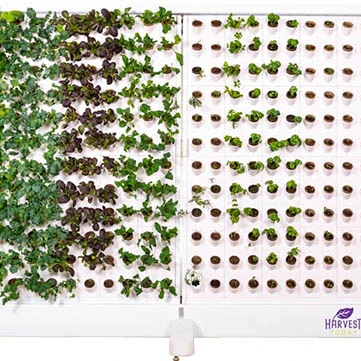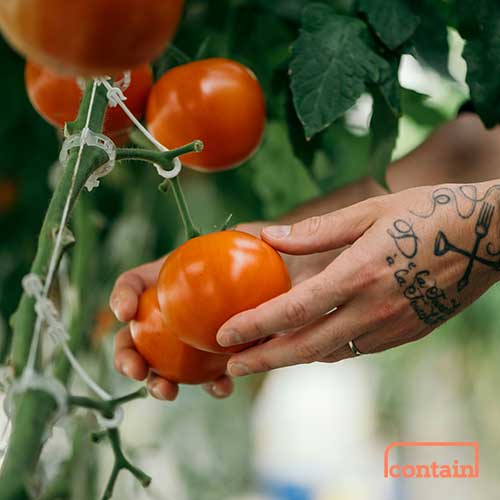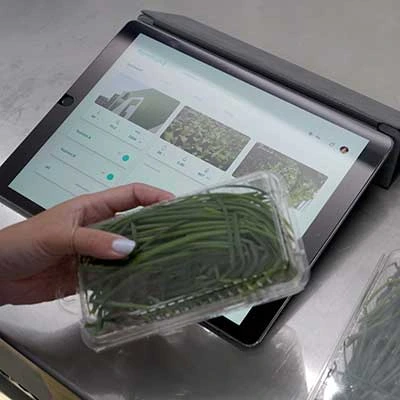March 10, 2024

The Controlled Environment Agriculture (CEA) industry finds itself at a crossroads. Recent bankruptcies have spotlighted the sector’s struggle with profitability, particularly for vertical farming ventures. Thankfully, there are plentiful efforts to find a solution.
One example is at urban farming company Square Roots, which is betting that advanced plant biology could be the key to revamping the CEA business model. We sat down with John Paul Boukis, Head of Business Development at Square Roots, to talk about their pivot and CEA business models.
About John Paul
John Paul comes from a long line of culinary experts. His grandfather was a chocolatier, and his grandmothers were both chefs. “So I was a little boy who grew up in the candy factory. It’s pretty cool.” he says. The tradition continues today with his brother, who runs a chocolate shop alongside his nephews.
John Paul took another path, spending more than two decades in marketing and strategic consulting. He worked with clients on issues like improving the quality and perception of hotel restaurants. Eventually, he was lured into controlled environment agriculture through a consulting project with vertical farming major Aerofarms. He formally joined the company in fall 2017 to focus on new business development.
“We focused on understanding the economics. of the things we could do with our technology stack” John Paul explains. “So that could mean different leafy greens. could mean herbs, it could mean berries. It could mean technology partnerships.” When Aerofarms’ strategy changed – it filed for Chapter 11 in June 2023 – John Paul found a new home at Square Roots.
Square Roots’ Pivot
Square Roots initially aimed to empower farm entrepreneurs through its urban farming platform. It empowered new urban farmers by providing them with the tools and technology to grow fresh produce, setting them up with their own container farming business. It has now pivoted to focus on creating a research platform for the Controlled Environment Agriculture industry.
Last month, it announced a grant from the Gates Foundation to pioneer heterotrophic growing techniques for low and middle-income countries. This approach is not new, but is more commonly associated with biotechnology and academic research than with commercial farming. It relies on organic carbon sources for plant growth, eliminating the need for sunlight. Theoretically, heterotrophic growing promises to boost crop yields, and enable year-round farming in areas that lack an accommodating climate.
By focusing on low and middle income countries, Square Roots aims to address global food security issues, offering a sustainable solution to agricultural limitations faced by these communities. The project kicks off by utilizing leafy greens for research but has plans to move into crops more familiar in its target markets, like potato and cassava.
The Current Landscape of CEA
Naturally, others have spotted the potential for the approach in developed countries. John Paul underscores the role of heterotrophic growing research in reducing dependency on artificial lighting. The aim is to cut energy costs and broaden the scope for indoor farming beyond “fancy leafy greens for Brooklyn hipsters”. It also helps address the greatest environmental ding on vertical farming, its reliance on energy-intensive lighting.
The promise of CEA to deliver sustainable, year-round crop production has been marred by financial instability. High-profile bankruptcies in the sector underscore the vulnerability of indoor farming companies. The root of the problem partially lies in the high operational costs associated with energy-intensive practices, notably lighting, and the limited crop diversity that focuses predominantly on leafy greens.
The Role of Heterotrophic Research
Heterotrophic growing methods rely on organic compounds as a carbon source instead of photosynthesis. They represent a shift in strategic thinking for an industry that has primarily focused on economies of scale. The approach aims to dramatically reduce the lighting energy demands of indoor farming, making it a more viable option across different geographies and crop varieties.
John Paul says that it’s too early for any solid estimates of the impact of their work, or to lay out a timeline for commercialization. That said, a rough guesstimate is that electricity makes up about a third of operational costs for a vertical farm. In 2021, Aerofarms estimated that its gross profit would be 19% in 2023, and 51% at run rate. It estimated a 10% drop in cost of goods sold from each successive iteration of its technology, far smaller than the potential fall from heterotropic growing. So, a successful heterotropic approach would be a game-changer for industry economics.
Funding the Future of CEA
Notably, Square Roots’ project is funded through a $4m grant from the Gates Foundation. The company previously raised $90m in venture funding, according to Crunchbase, but it’s difficult to fund long term research with impatient capital.
John Paul emphasizes the importance of a balanced funding model to propel the CEA industry: “I think pre-competitive work should look toward university and public funding…we have lots of people at USDA who do work for farmers.” So, he sees a growing need for public-private partnerships to support pre-competitive research. Such collaborations could accelerate the development of climate-resilient crop varieties, recognizing that a better agricultural ecosystem is a public good.
In addition to the Gates Foundation grant, Square Roots is using its platform to custom design high nutrient salad mixes for two major health care groups in the Midwest. It also has molecular farming initiatives. Going forward, it is especially interested in developing valuable compounds in plants for nutrition and ‘food as medicine’.
It’s clear that a symbiosis of technology, biology, and innovative funding will be key to redefining controlled environment agriculture.
Image Courtesy of Unsplash

Indoor Agriculture Pivots to Home Gardens as Vertical Farming Failures Drive Strategic Reevaluation

Zordi Series B and May 2025 Indoor Agriculture Developments

Freight Farms Bankruptcy and iUNU’s $20M Raise Highlight April’s Indoor Ag Contrasts

Freight Farms Resources: Indoor Ag Companies Stepping Up to Support Freight Farmers

How to Finance Your Hydroponic Project in 2025: Finding Opportunity in a Shifting Market

Indoor Ag’s New Reality: Practical Advice from Investment Banker Adam Bergman

Plenty Unlimited bankruptcy dominates March’s indoor ag news, overshadowing new farm plans

80 Acres Farms secures $115m, Square Roots expands to Japan, and indoor ag sees farm shakeups in February

Robobees take flight, vanilla goes vertical, and a new IPO is on the horizon in indoor agriculture’s January

Canadian Agriculture Grants: 7 Funding Opportunities for Indoor Farming in 2025

Indoor Ag Outlook: Funding Trends and 2025 Projections
